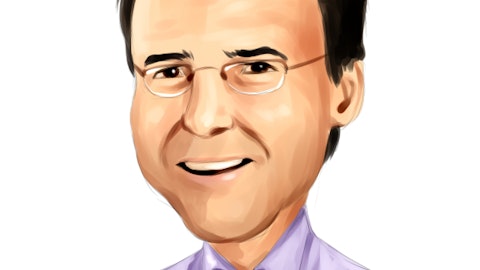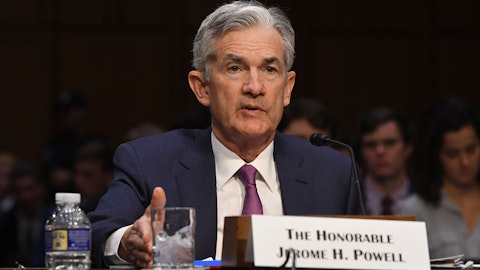Kevin Barker: Good morning. Thanks for taking my questions. You previously guided to capital generation or return on receivables. And I understand you’re not doing that now, but maybe you can help us understand some of the components that would make — some help — give an idea of where capital generation could come in for 2023, just given some of the headwinds from the card side as you grow that portfolio combined with asset yields coming down a bit just because of lower — I mean, higher interest rates and tightening of underwriting standards. Thank you.
Micah Conrad: Yes, Kevin. This is Micah. I’ll take that one. I mean as Doug mentioned, there is €“ it’s pretty tricky in this environment to give full year forecast. We’ve kind of given you the receivables growth as we mentioned we feel that’s pretty resilient, unless we see a major significant or a rapid change in the environment. Obviously, the losses we got it to the 7% to 7.5%. Again, I think it’s €“ this is a matter of having a relatively stable outlook. So our losses the range that we’ve given you gives some room for unemployment to pick up a bit. And as you know, we have a 180-day charge-off period. So in order for that really to impact losses, it would have to happen pretty quickly generally in the first half of the year to really move the needle on that.
In terms of yield, a little bit in my prepared remarks yield also impacted by the macro environment and a level of 90-plus receivables. So, certainly, giving you a little bit of sense for that without calling out a specific full year number. We do expect loan yield to be right around fourth quarter levels in the first quarter. And then sort of as we get through the balance of the year we expect some of the 90-plus levels to just subside because of normal seasonal patterns, but also as our front book or these post August originations start to take a little bit bigger hold in the receivables book. So that should give us a little bit of runway and upside on yield. I think on interest expense, again, just mentioning generally in the prepared remarks, the way we’ve staggered our maturities.
It just takes a lot to move interest expense quite a bit in one year. So interest expense in 2021, was around 5%, 5.1%; in 2022 4.6%; pretty likely we’ll be somewhere in the middle of that in 2023. And so I think that should give you some sense for how to build the interest expense piece of that. And we’ve given you also the expenses at about 7.1% OpEx ratio. So €“ that’s for the most part, the lion’s share of our capital generation. I think, we’ve seen some year-end improvements in our policyholder benefits and claims line, some reserve adjustments we expect those to normalize back to levels around 45 to 50 a quarter. And I think, when you add all that up, we would expect to see capital generation lower than what we experienced in 2022. But with kind of some runway at the end of the year we think that can pretty much snap back in 2024 back to those levels.
And that’s kind of where we are.
Kevin Barker: Great. Yeah. You touched on some macro factors there where the net charge-off would be closer to the high end with a little bit higher unemployment. Could you help us understand what macro factors you apply within your guidance assumptions for 7% to 7.5% net charge-offs? And then what are you seeing within your customer base? You touched on some stress within the non-prime consumer just given the inflationary outlook but maybe just a little more color on your macro assumptions to get to the net charge-off guide?
Micah Conrad: Yeah. So let me touch on the customer first. As we talked about in, I think numerous forums we obviously saw a pretty rapid increase in 30 to 89 delinquency in the second quarter, when it increased about 50 basis points from the first. And then since then we’ve seen relative stability. And what I mean by that is we’ve seen seasonal patterns kind of emerge, where we went from second quarter to fourth quarter up about 30 basis points or so this year, 30 to 89 and it was pretty similar to 2018 and 2019. So we’ve seen some nice stability there. Certainly inflation is still impacting our consumers, but we feel pretty good about where things stand. I mentioned also in January, we saw a little bit of a seasonal downtick in January 30 to 89.
And tech season is coming. So we hope that’s going to be really accretive and helpful for our consumer. That’s influencing some of what we’re thinking about in our loss guide, bottom end 7%; top end 7.5%. I would say on the top end is an environment that’s pretty consistent with what we’re — in what we’re assuming in our reserve numbers which is an unemployment rate somewhere in the 4.5% to 5% range, obviously, unemployment in the low threes now and pretty supportive for the time being. So those are kind of the guardrails. And keep in mind, also, with our charge-off policy, again, without any really impacts to the back end and what’s happening in those 90, 120 and 150-plus receivables. In order to have a really dramatic move, I think in the back half of the year on losses, you’d have to see something in the early-stage delinquency happening pretty quickly.
And that’s hard to foresee right now, given the employment prints and the claims numbers that we’re seeing.
Kevin Barker: Okay. Thank you, Micah.
Micah Conrad: You’re welcome.
Operator: The next question comes from Michael Kaye from Wells Fargo.
Michael Kaye: My first question is on the credit card. I wanted to get some thoughts on that impact of that CFPB proposal on late fees. How does that impact the pace of the loan balance launch over the next few years? I was wondering, if you perhaps emphasize BrightWay+ over the BrightWay considering that overhang — and then that aside how do you balance this growth opportunity with the rolling out like nonprime credit card ahead of an expected recession? And I know, it’s mostly a test portfolio at this point, but I couldn’t help noticing that the delinquencies for credit cards are already 14.5% as of Q3. Just wanted some thoughts. Thanks.





